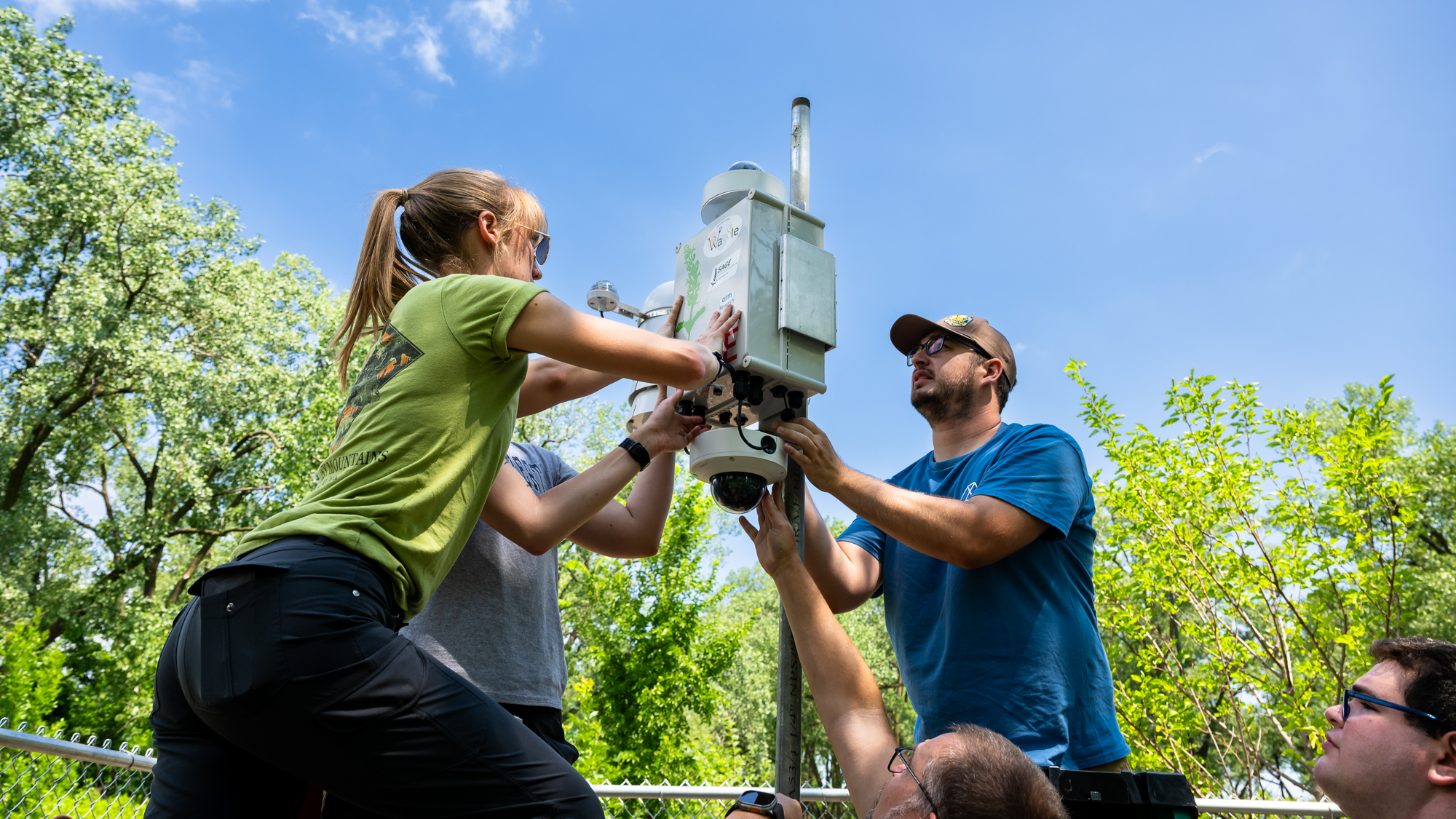Summer in the city has looked (or felt) a bit different this year. From a historic drought, to smoke from the Canadian wildfires, to extreme changes in weather, the impacts of climate change have very much been center stage for Chicagoland residents. But just how great of an impact can differ simply by your address.
To better understand this, particularly for historically under-resourced, disinvested communities that are more vulnerable to the effects of climate change, scientists from the U.S. Department of Energy’s (DOE) Argonne National Laboratory and Chicago State University (CSU) will deploy a set of scientific instruments on Jul. 18.
These are among the first installations of scientific instruments for the Urban Integrated Field Laboratory called Community Research on Climate and Urban Science (CROCUS) in Chicago. CROCUS is a five-year, $25 million program carried out by a team of 17 organizations, and funded by DOE’s Office of Science, Office of Biological and Environmental Research. The project seeks to understand how climate change will affect urban areas.
“The recent historic precipitation events are just one more reminder of how the climate is going to change in the Chicago region and how great the risks of climate change are to day-to-day health and wellbeing. Through CROCUS, we have an opportunity to work together and conduct research that will assess and address local climate problems in an equitable and relevant way.” — Cristina Negri, director of Argonne’s Environmental Science division and the lead investigator on the CROCUS project
This is the second CROCUS deployment — the first of which occurred in May at Northeastern Illinois University. CSU serves as the southern end of the project’s node network, with more than 20 sensor arrays to be deployed over the next 5 years across the city to gather more data on Chicago’s changing climate.
During the Jul. 18 deployment at CSU, instrumentation will be placed on the rooftop and two ground locations. The equipment will measure air quality, weather conditions, rain and soil conditions. Researchers are especially excited to gather data on and in the ground at CSU. The nearby neighborhood of Chatham experiences some of the most extreme flooding in Chicago and the heavier, more frequent rains associated with climate change will only make matters worse. The new sensors will help researchers understand how much water different surfaces, landscapes and vegetation can absorb or channel away, important information for making communities like Chatham climate resilient.
“For communities on Chicago’s South Side, like Roseland, West Chesterfield and Chatham, the effects of climate change have significantly impacted the quality of life for residents. CROCUS will provide us with the necessary data to better understand the environmental disparities and empower our communities to deploy solutions,” said Dr. Tekleab Gala, professor of Geomatics, Chicago State University.
CROCUS’s team of researchers are looking for big-picture data on how weather patterns will change over the next 10 to 50 years as well as more detailed data on what’s happening now, on a neighborhood-by-neighborhood basis. That’s because individual neighborhoods and even city blocks have their own microclimates. These conditions are shaped by everything from the number of trees and greenspaces in the area to the height and color of the rooftops to the historical use of the land on which the neighborhood was built.
Chicago’s microclimates interact with each other in a complex quilt which in turn interacts with the climates of the surrounding suburbs, farmland and Lake Michigan. Sensors like the ones deployed today will give researchers greater insight into how those microclimates work. The data collected will allow researchers to create long-term models to better predict how climate change could impact Chicago and other urban areas across the Great Lakes region. In other words, we’ll be able to view that complex quilt and predict how it will change over time.
Timely data on heat islands, flooding and extreme weather will help communities better understand issues that need to be addressed right now to protect their families, neighbors, homes and businesses.
“The recent historic precipitation events are just one more reminder of how the climate is going to change in the Chicago region and how great the risks of climate change are to day-to-day health and wellbeing. Through CROCUS, we have an opportunity to work together and conduct research that will assess and address local climate problems in an equitable and relevant way,” said Cristina Negri, director of Argonne’s Environmental Science division and the lead investigator on the CROCUS project.
CROCUS is a collaborative study that involves academic, community and civic partners including Argonne, Chicago State University, City Colleges of Chicago, North Carolina A&T State University, Northeastern Illinois University, Northwestern University, University of Chicago, University of Illinois Chicago, University of Illinois Urbana-Champaign, University of Notre Dame, University of Wisconsin-Madison, University of Texas-Austin and Washington University-St. Louis. CROCUS also partners with Discovery Partners Institute in Chicago and with CIEMAT in Spain.
CROCUS community organizations include Blacks in Green, Greater Chatham Initiative, Puerto Rican Agenda and the Metropolitan Mayors Caucus.
Learn more about CROCUS at crocus-urban.org.
Chicago State University (CSU), founded in 1867, is the oldest public university in the Chicago Metropolitan area. The University’s five colleges offer over 70 undergraduate and graduate degree-granting and non-degree programs. CSU is committed to equity in education, serving as the only U.S. Department of Education-designated four-year Predominantly Black Institution in Illinois and ranked by a Harvard economist in the top 4% of public and private universities nationwide in supporting our graduates’ economic mobility. The University serves as a prominent civic space on the greater South Side of Chicago by hosting a multitude of athletic, educational, cultural, and recreational activities. The University is located near public transit that provides convenient access to the campus. Visit www.csu.edu.
Argonne National Laboratory seeks solutions to pressing national problems in science and technology. The nation’s first national laboratory, Argonne conducts leading-edge basic and applied scientific research in virtually every scientific discipline. Argonne researchers work closely with researchers from hundreds of companies, universities, and federal, state and municipal agencies to help them solve their specific problems, advance America’s scientific leadership and prepare the nation for a better future. With employees from more than 60 nations, Argonne is managed by UChicago Argonne, LLC for the U.S. Department of Energy’s Office of Science.
The U.S. Department of Energy’s Office of Science is the single largest supporter of basic research in the physical sciences in the United States and is working to address some of the most pressing challenges of our time. For more information, visit https://energy.gov/science.



